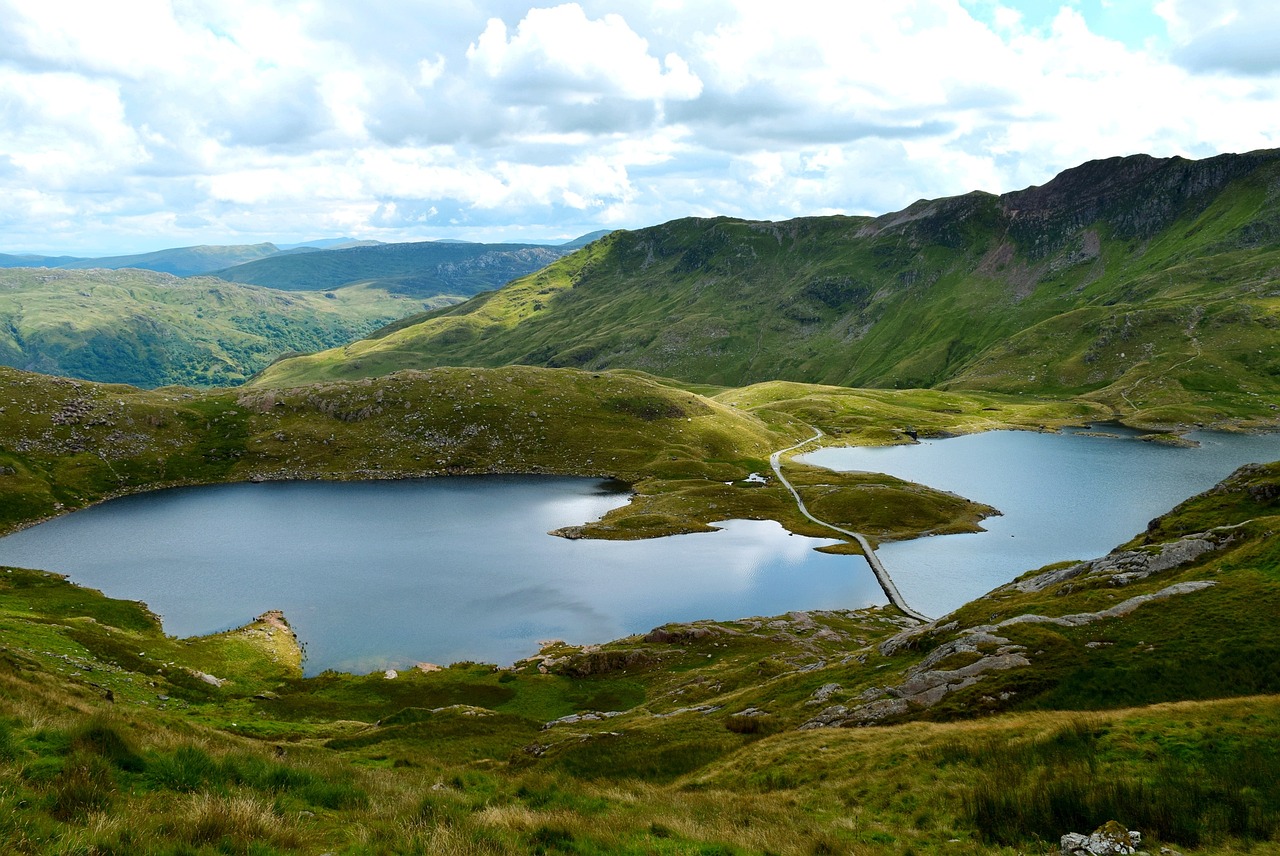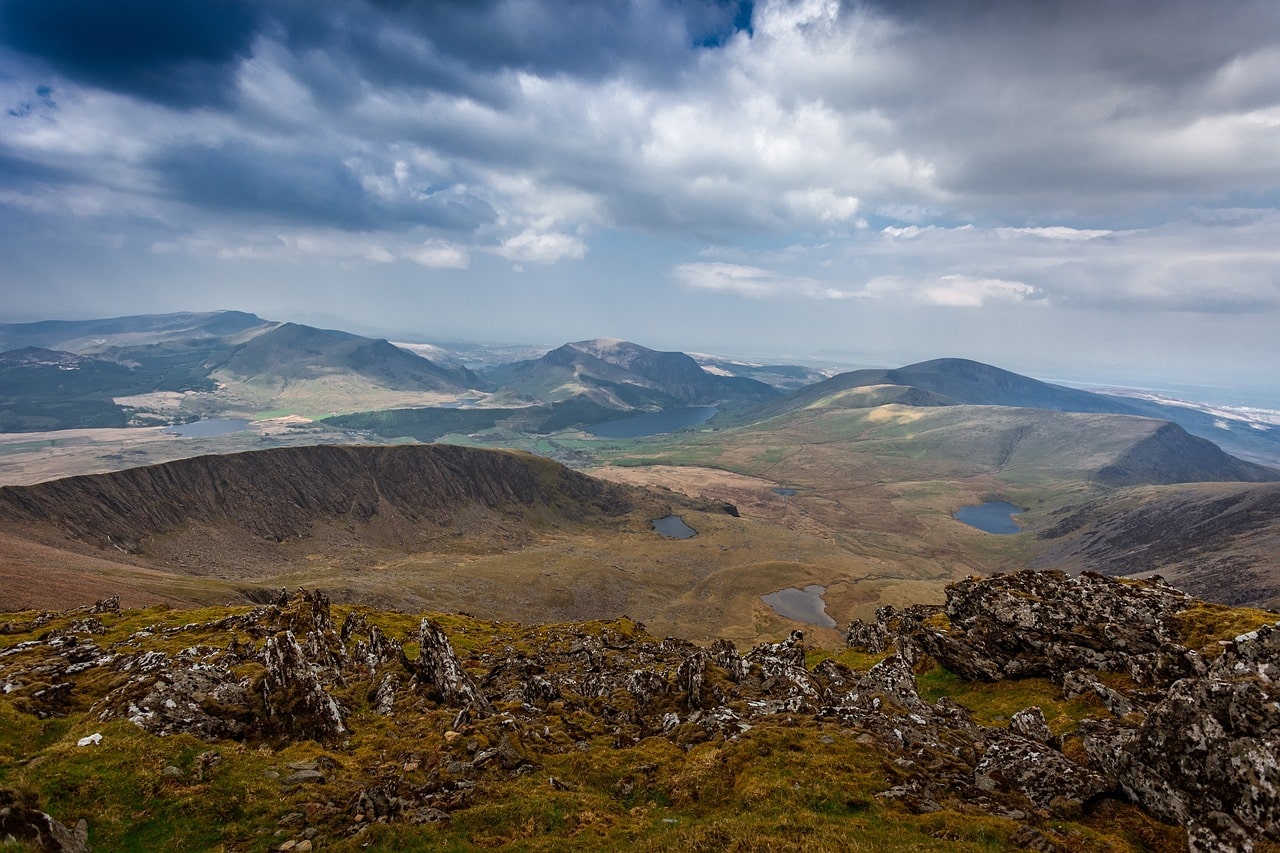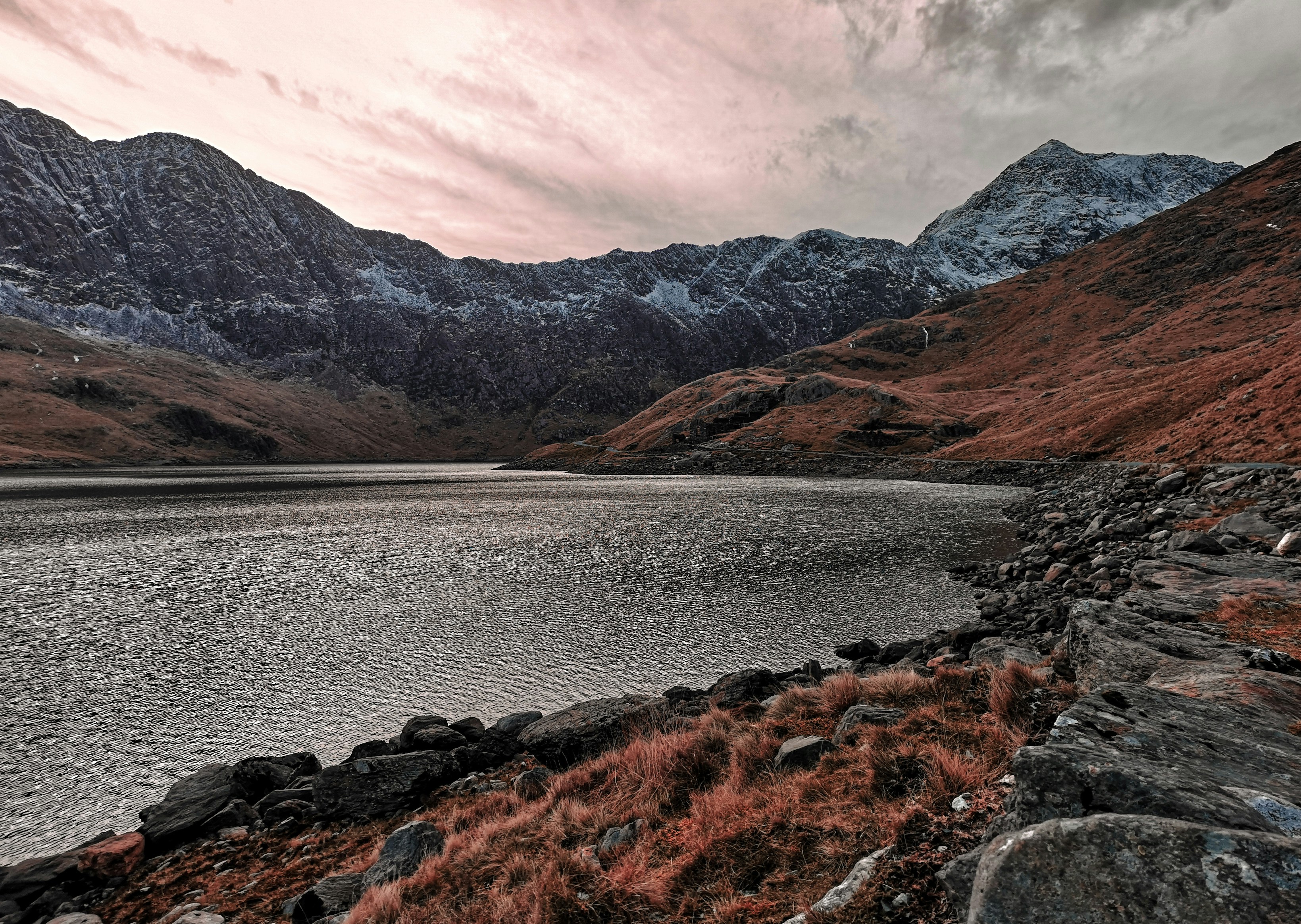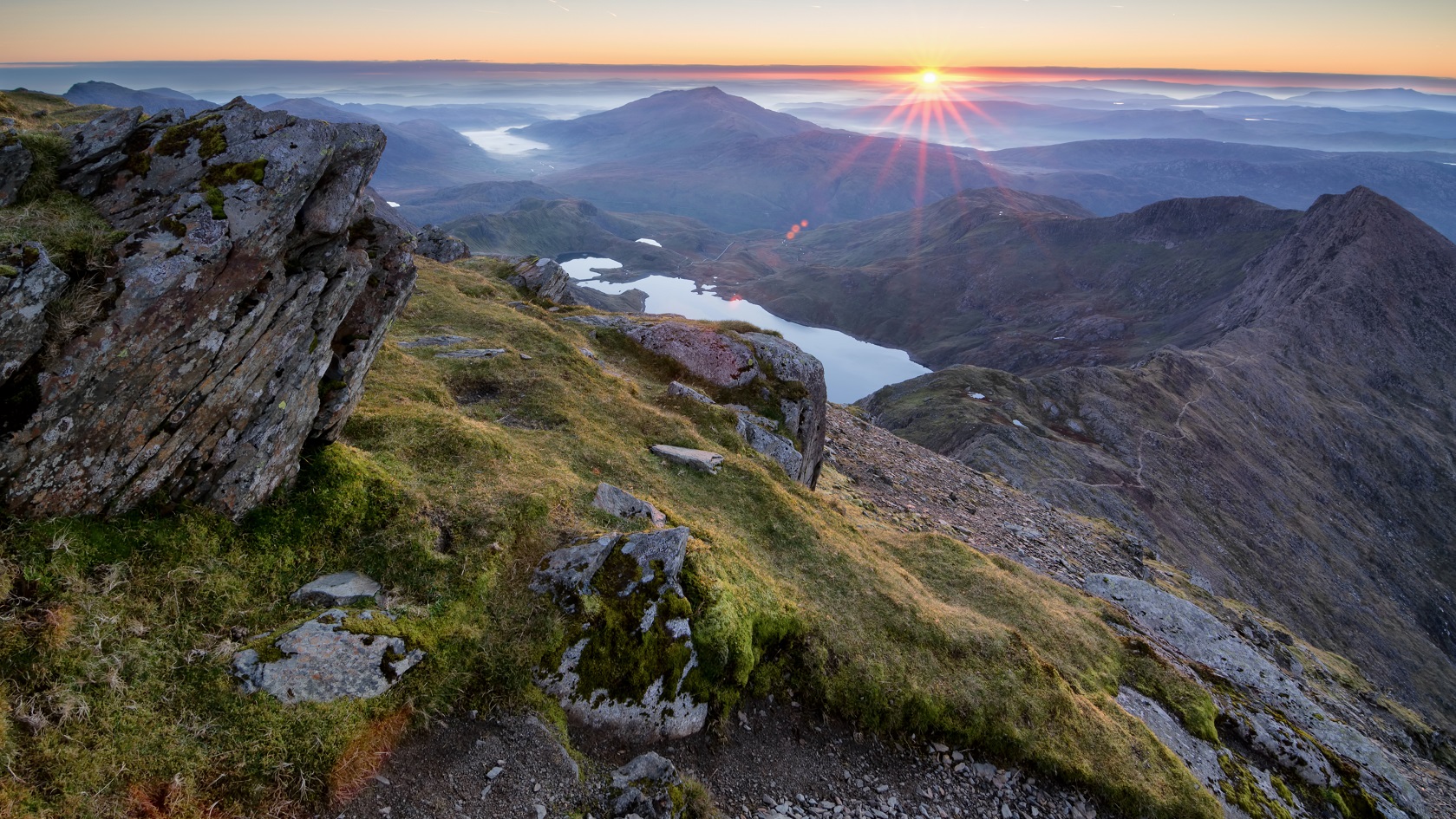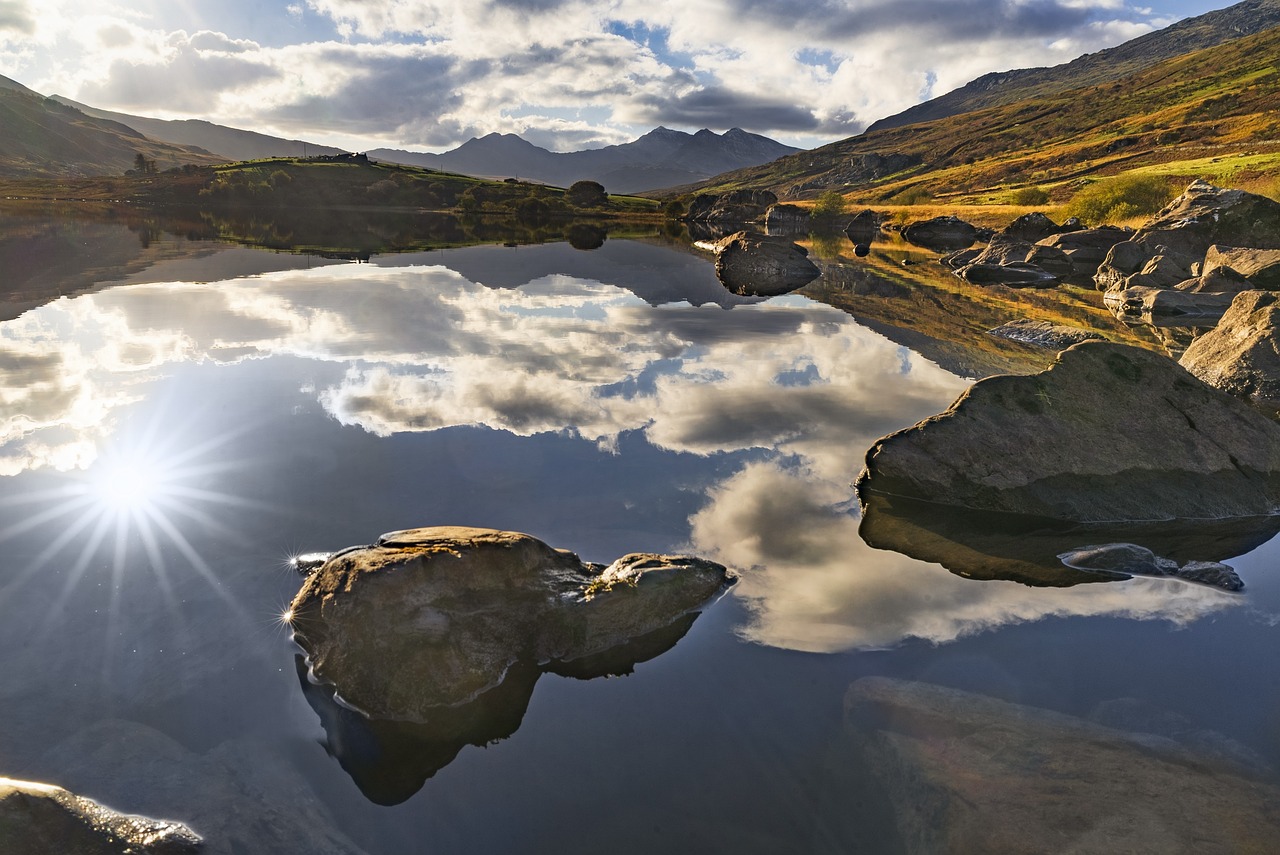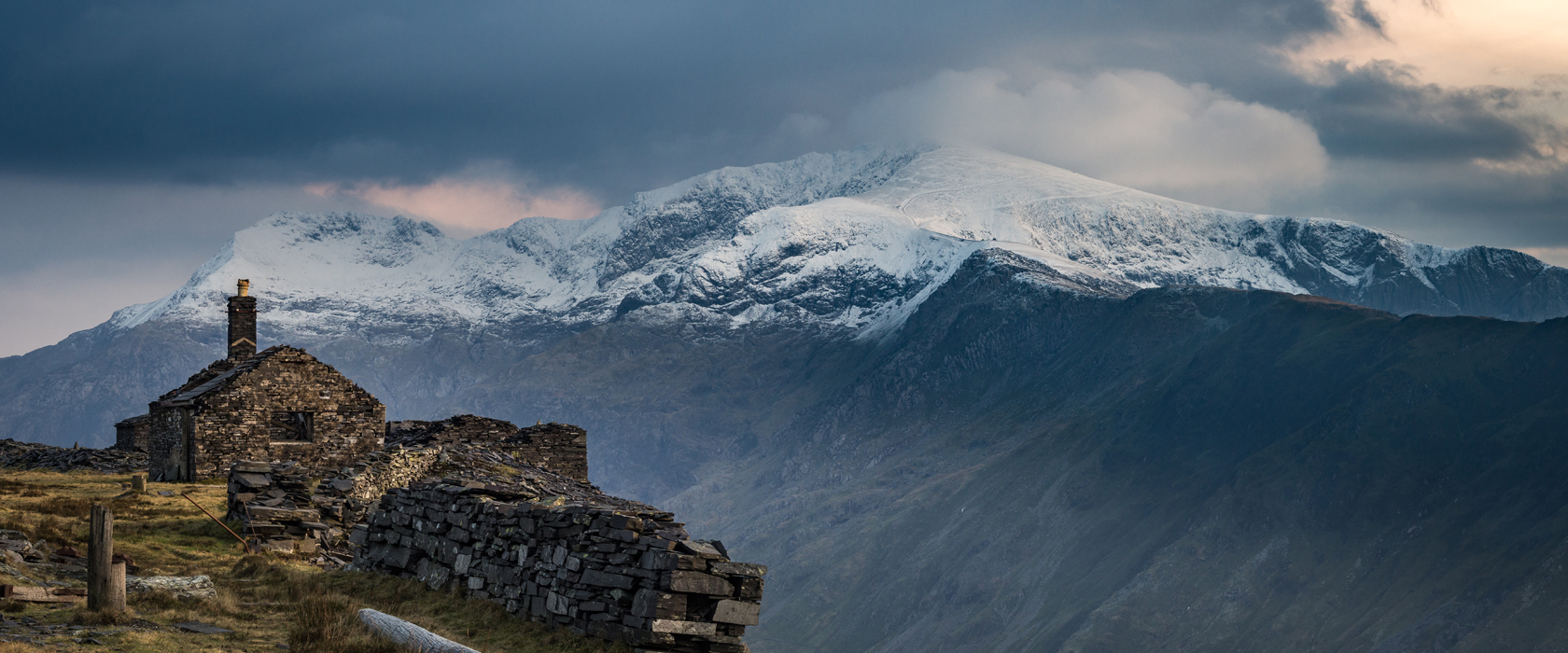Snowdonia National Park (Welsh: Parc Cenedlaethol Eryri) is a national park in Gwynedd, northwest Wales. It was established in 1951 as the third national park in Britain, following the Peak District and the Lake District. Snowdonia is an incredibly scenic and rugged landscape, covering over 800 square miles, with striking glacial landforms sculpted during recent ice ages. The park takes its English name from Snowdon, which at 3,560 feet high is the highest mountain in Wales. In Welsh, Snowdon is known as Yr Wyddfa, meaning “the tumulus”, as its summit was once used as a burial site.
Snowdonia contains some of the finest mountain landscapes in Europe. There are over 100 peaks within the park, many with evocative Welsh or English names that speak of their unique shapes and characters - Tryfan, Glyder Fawr, Crib Goch, Cadair Idris, Moel Siabod, to name just a few. Besides rock climbing and hiking amongst these peaks, Snowdonia offers excellent opportunities for a wide range of outdoor pursuits like mountain biking, kayaking, sailing and more.
As one of Britain’s premier national parks, Snowdonia receives over 6 million visitors per year. It has a long history of tourism and outdoor recreation. As early as the Victorian period people flocked to Snowdonia to enjoy the sublime mountain scenery and bracing air. Many of the classic routes to ascend Snowdon's Peak were constructed during this period. The tourism boom led to the construction of many grand hotels and impressive railway lines to transport tourists directly into the heart of the mountains.
Accommodation and Facilities in Snowdonia
Snowdonia National Park offers a wide variety of accommodation and facilities to enhance visitors’ experiences. Options range from hotels and holiday cottages to campgrounds, along with villages that provide restaurants, shops and other useful services.
Hotels
Snowdonia National Park hotels range from remote historic inns to grand Victorian establishments constructed during the dawn of tourism, with atmospheric bars or lounges perfect for relaxing after full days exploring the countryside. Accommodation map of Snowdonia National Park pinpoints over a hundred establishments ranging from remote trailside bunkhouses to posh modern resorts with views of iconic peaks. Summit reward schemes at partner locations provide hiker discounts. Early booking secures rooms in peak seasons.
For visitors desiring refined relaxation after full days exploring Snowdonia’s rugged landscapes, Plas Tan y Bwlch provides an oasis of luxury accommodations and fine dining befitting 19th century gentry. This imposing stone mansion overlooking tranquil Lake Tecwyn traces its pedigree back to a 16th century estate. Period architecture and manicured gardens retain its heritage as a country manor for wealthy landowners. Inside, many rooms sport ornate fireplaces, four poster beds and claw foot tubs offering Victorian opulence.
Holiday Cottages
Beyond hotels inhabit historic slate cottages sprinkled through Snowdonia villages like Betws-y-Coed. Once housing quarrymen and railway workers, many now provide charming self-catering accommodation letting visitors glimpse authentic Welsh life of past centuries merged with modern comforts. Snowdonia holiday parks near Beddgelert, an iconic village tucked at the foot of the tallest mountain, offer entire cottages or suites of various sizes suitable for couples to large gatherings. Most feature cosy lounges with fireplaces plus well-equipped kitchens so guests can cook with tasty local fare from the village butcher, bakery and grocer. More solitary cottages down winding lanes provide exclusive use of remote hideaways. Ffynnon Gwyn cottage lies surrounded only by forests and peaks north ofnational park Wales Snowdonia. Solar power and a natural spring that inspired its name meaning “white well” provide off-grid ambiance. Owners promise guests may even spot mythical giants and wizards rumored to dwell deep in these secluded woods below Moel Siabod’s dolomite crags! Sites near snowdonia through agencies like UnderTheThatch, National Trust Holiday Cottages and Independent Cottages showcase hundreds of tempting self-catering options in stone cottages steeped in history. Filter location, size, budget and amenities like wood-fired hot tubs to discover potential bases matching your party’s Snowdonia adventure vision.
Campsites
Rugged Snowdonia camping sites allow sleeping under the stars surrounded by majestic peaks not visible from inside four walls. Whether in organised holiday parks with amenities or remote wilderness settings, waking to golden light cresting craggy ridgelines makes early rises shine.
Hafod y Llan National Park campground occupies a secluded forest beside the Llanberis Path on Snowdon. Campers can hike directly from their site towards the lofty peak. Shared amenity blocks supply hot showers while camping pods provide drier comfort during typical Snowdonia downpours. Their camp cafe offers classic bacon butties or more specialised fare like vegan curries. Boutique glamping sites near Llyn Ogwen add luxurious touches like antique furnishings inside roomy safari tents warmed by wood-burning stoves. Snowdon View Shepherd Huts provides hot tubs from which glowing constellations seemingly close enough to touch rotate overhead as the moon crests between peaks.
Remoter eco-lodges at sustainable Snowdonia holiday parks use renewable energy and harvested water for carbon-conscious campers. Their outdoor classrooms foster nature connection through forest education programming for kids relishing the wildness. Yet cosy yurts and cottages keep families content even during classic Snowdonia National Park weather better endured beside a crackling fire with steaming mugs of cocoa or cider. True backcountry adventurers bring ultra-light tents to commit themselves fully to Snowdonia’s rugged landscapes, practising leave-no-trace ethics across fragile terrain reserved only for the bold willing to sacrifice all creature comforts in exchange for pristine panoramas and hard-won solitude. Careful arrangements made ahead through park authorities grant limited primitive camping outside the valleys in areas otherwise restricted, keeping irreplaceable habitats protected
Learn more about your camping options in Snowdonia National Park here.
Outdoor Activities in Snowdonia National Park
Snowdonia’s spectacular landscapes offer limitless outdoor recreation opportunities to get active amidst wondrous scenery. Iconic pursuits include hiking, climbing, mountain biking, kayaking and sailing.
Hiking & Climbing in Snowdonia
With one of Britain’s foremost mountain wilderness areas on its doorstep, Snowdonia creates unlimited potential for hiking and climbing adventures amidst majestic summits immortalised in Welsh folklore and mountaineering history.
As the tallest mountain in Wales, Snowdon (Yr Wyddfa) stands as an iconic mecca luring hikers and climbers to make a pilgrimage to its 3,560 ft summit. While not extreme in global terms, it offers a variety of route options catering from casual day trippers to scramblers seeking exposure and technical challenges. The easiest route follows the Llanberis Path’s gradual grade starting from the mountain’s longest lakeside. Even novices can achieve the 5 mile round trip to stand atop the national park’s namesake. Some may prefer the Snowdon Ranger Path’s gentler ascent from the east passing a historic inn near a scenic reservoir nestled below the peak. For more intrepid visitors, the knife-edge arête along Crib Goch provides renown as Britain’s most notorious ridge scramble outside serious alpine climbs. Scramblers carefully weave along foot-wide stone walkways teetering hundreds of feet above steep cliffs. Gusting winds and slippery rocks warrant ropes, helmets and scrambling skill using hands for balance.
The adjacent Pyg Track offers a scenic alternative crossing high passes culminating in arrival at a spectacular glacial cirque known as Cwm Glas. Sheer cliffs frame a lake overlook under the rocky pyramid finale. Loose scree and the notorious “zig-zags” on the last push demand fitness. But breathtaking views emerging over misty peaks stretching along Snowdonia’s interior make it hugely popular regardless of its challenges. To avoid hordes of summer visitors on main tracks, try ascending Snowdon’s quieter but steeper Watkin Path from Nant Gwynant or the Rhyd Ddu Path traversing verdant alpine meadows decorated in wildflowers. This longest route includes a scenic waterfall before eventually reaching the wind-hammered trig point crowning Wales in all its glory on clearer days. Prepare for any weather regardless of chosen route!
Neighboring peaks deliver equal rewards less affected by crowds. The Glyderau present a rocky wonderland of sculpted summits for experienced scramblers to link together on airy ridges staring down vertical cliffs into dark glacial cwms. 14th century bard Iolo Goch compared Tryfan’s iconic twin monoliths to the bifid tongue of a snake - a metaphor for the crumbling rock’s treachery. Cadair Idris to the south offers seemingly endless bridleway hiking around its broad flanks but gets serious for a steep, rocky scramble up the Pony Path to an iconic summit viewpoint over southern Snowdonia as frigid waters of Llyn Cau crash 500 meters below at Pen y Gader.
Mountain Biking & Cycling in Snowdonia
While some footpaths prohibit bicycles, Snowdonia still offers scenic cycling routes linking villages, forests and more lenient trails. Gravity-fed downhill tracks also deliver technical thrills for skilled riders.
Leisurely rides such as the Mawddach Trail follow a disused railway along the estuary between Dolgellau and the seaside town of Barmouth. Nearly level grade combined with sublime views makes this suitable for all abilities. The Antur Stiniog Downhill Trails above Blaenau Ffestiniog ascend 700 vertical meters via uplift shuttle to the trailhead. Adrenaline seekers then pick from four graded downhill runs stretching 2.5 km back to town. Optional jumps, berms and rock slabs provide playful features as trails meander down through the forest.
Tucked into the Gwydyr Forest north of Betws-y-Coed, the Marin Trail has become a premier destination for cross-country mountain bikers seeking natural terrain with rooty technical challenges intermixed between adrenaline-pumping descents and smoother meandering phases through green grade forest. Extending 27 kilometers in a loop accessed from Llanrwst or Betws-y-Coed, riders can tailor routes for different ability levels. Novice and kid-friendly sections trace gentler bridleways wide enough for side-by-side riding past babbling creeks beneath the lush forest canopy. Other narrow climbs traverse root-woven singletrack up short punchy ascents to intersections where riders can choose more advanced options.
The trail’s namesake company, Marin Bikes, originally helped develop routes in collaboration with forestry officials and local groups to designate phased descending rides utilising some pre-existing paths. Theirflowy “blue” sections appeal to intermediates gliding down smooth trails while avoiding gnarly “black” diamond routes plunging straight down eroded gullies and rock gardens better tackled slowly to avoid crashing. Natural terrain aspects make parts of the Marin Trail system more challenging than typical machine-built bike park routes. Unexpected side slopes off camber around trees demand precision balance to rail loose corners without slipping. Rocky staircase drops test a rider’s ability to pick smooth lines while maintaining momentum over awkward embedded boulders. But with risk comes reward. The trail network frequently emerges suddenly from dense woods out onto open hillsides draped in heather blooms offering panoramic vistas over green valleys before diving back into the trees.
Watersports in Snowdonia
Snowdonia’s abundance of lakes, rivers and nearby coastal fronts offer wonderful conditions for watersports like sailing, kayaking and windsurfing amidst picturesque backdrops. Hardy sea kayakers can embark directly into the ocean from Harlech Beach below its iconic medieval castle. More sheltered areas like the Glaslyn Estuary near Porthmadog give calmer access across glassy waters reflecting the peaks overhead. Guided tours lead beginners through proper kayak handling before exploring hidden coves and sea caves punctuating a breathtaking coastline.
Inland lakes including massive Bala Lake and serene Llyn Ogwen invite leisurely paddles under usually relaxed conditions. Many outdoor centers around these lakes rent canoes, kayaks and stand up paddleboards for independent outings or offer beginner paddling courses if you’d rather learn proper technique. White water kayaking on pumping grade 3 rapids of the Tryweryn River near Bala provides an exciting ride for experienced paddlers. Releases from Llyn Celyn reservoir upstream creates scheduled artificial floods surging through this notorious kayaking run. Groups tackle frothing chutes with names like “Mincer” whilst solo experts spin and flip between hydraulics along this Grade III-IV stretch.
When to Visit Snowdonia National Park
Snowdonia National Park offers breathtaking landscapes and outdoor recreation opportunities throughout the year. However, the best time to visit depends greatly on your interests, tolerance for crowds, and appetite for adventure in more extreme mountain conditions.
Summer Months
June through early September tends to provide the most stable weather, with warmer temperatures and less frequent storms compared to other seasons. As most visitor facilities only operate during summer, it is by far the most popular season. All main visitor centres, museums, guided tour operators, leisure attractions, restaurants and public transportation schedules ramp up to full capacity. Peak services on both the Snowdon Mountain Railway and Snowdon Sherpa Bus also run frequently during summer. Accommodations reach full occupancy during July and August when British schools have a break. Expect summertime crowds on Snowdon’s main hiking paths as people flock to ascend the famous peak under more favourable conditions. Meanwhile, the tiny mountain lake of Glaslyn transforms into a popular beach destination along the Miner’s Track descent route. For those less fond of crowds yet wanting predictable mountain conditions for hiking, climbing, mountain biking or paddling, late spring (May-June) or early autumn (September) may provide a suitable balance with fewer tourists, longer daylight hours than winter and typically more stable weather.
Winter Months
While Snowdonia remains open all year, winter transforms the park into a vastly different setting. Icy conditions, heavy snowfall and shorter days demand proper preparation and specialised gear to safely enjoy winter adventures amidst the elements. Ice climbers arrive seeking frozen waterfalls and reformed landforms encased in ice to scale. Competent winter mountaineers ascend snow-plastered peaks using crampons, axes and ropes for glacier travel and self-arrest techniques. More extreme ascents may require building emergency snow shelters if caught out overnight. Meanwhile, snowsports enthusiasts flock to the Summit to Sea artificial ski slope at Llanberis or natural snowfields to snowboard, sledge, snowshoe hike or cross-country ski as conditions allow. By January snowfall occasionally accumulates sufficiently for Scottish ski touring groups to cross the border seeking fresh descents. Foremost, winter visitors must carefully assess avalanche reports, pack the proper equipment and attune navigation skills to whiteout conditions. But braving Snowdonia’s coldest season rewards hardy explorers with remarkable arctic-like scenery utterly transformed from its summer state.
Snowdonia's Unique Wildlife
Snowdonia National Park provides a vital habitat for an array of plants and animals uniquely adapted to thrive in its various mountainous landscapes. Getting to know this specialised flora and fauna adds an extra dimension to appreciating the biodiversity sheltered between these craggy peaks.
Alpine & Subalpine Species
Above 1,000 feet in altitude, only the hardiest arctic-alpine species can endure Snowdonia’s high-elevation conditions. Fierce winds, prolonged snow cover and thin soils make survival difficult. Yet colourful mats of mosses, grasses and wildflowers cling to existence amongst the inhospitable rocks.
Stubby vascular plants like the Snowdon lily and viviparous fescue grass thrive where other flowering species cannot. They employ unusual adaptations to ensure reproduction in their limited growing season - some reproduce asexually while others nurture their seeds internally before giving live birth. Snowdonia’s most famous floral icon - the Snowdon lily (Gagea serotina), erupts in a burst of bright yellow blooms for just a few short weeks from late April. This rare mountain flower grows nowhere else except Snowdon’s high slopes. Its bulb stores energy underground, waiting out the long winters to send up leaves and flowers when sunlight returns. Keen botanists admire other rarities like purple saxifrage, roseroot and alpine pennycress that also decorate the high mountain scree. Higher up only mosses and lichens envelop the inhospitable boulder fields and cliffs in splashes of green and orange. Reindeer lichen species cling tightly to rocky faces. Unlike more complex plants, they can photosynthesise frozen solids through the winter. Come spring, nematodes preserved in this lichen crust also revive to consume bacteria and fungi in the melting snows.
Woodland & Forest Dwellers
While casual visitors focus their gaze upward towards the peaks, a diversity of wildlife also dwells within Snowdonia's wooded valleys and lower slopes. One of Europe's rarest mammals, the polecat, stealthily hunts amongst the oak forests near Betws-y-Coed. This agile weasel species nearly died out in Wales early last century from hunting and habitat loss. But conservation efforts including breeding programs and forest protections have slowly revived populations of this shy creature with few sight aside from the occasional roadkill.
Meanwhile, invasive grey squirrels imported from North America now dominate broadleaf woodlands that once hosted Europe's smaller native red squirrel in abundance. Greys carry a pox virus lethal to reds but harmless amongst themselves, decimating remaining scattered native populations clinging to conifer forests like Beddgelert Forest. Other non-native species including the European Larch, Sika Deer, Rhododendron ponticum and American Signal Crayfish continue altering the ancient ecological composition of Snowdonia's woods and waterways.
Snowdonia's Unique Geology
Snowdonia National Park displays immense geological diversity for a relatively small region. Its rocks tell stories spanning over 500 million years of Earth history - from ancient volcanoes to recent ice ages. These varied rock types and dramatic landforms underpin the region's scenic beauty.
Very Ancient Rocks
The most ancient rocks exposed in Snowdonia formed over 500 million years ago during the Cambrian period. Small outcrops visible around Cadair Idris represent some of the oldest sections of the Earth's crust in Britain. Composed of hardened marine sediments like mudstone and gritty sandstones, these formations originally accumulated on an ancient sea floor. Intense heat and pressure during the mountain-building Caledonian Orogeny around 400 million years ago contorted and transformed these Cambrian marine deposits into durable metamorphic rocks. Traces of this turbulent past persist as distinct banding within the now hard schist and quartzite formations comprising the southern flank of Cadair Idris. Slightly younger Ordovician and Silurian period marine sediments eroded off the immense mountains uplifted during this collision and also accumulated within the Snowdonia area over 425 million years ago. Compressed over time, these became the region’s valuable slate deposits. Vast slate quarries around Blaenau Ffestiniog and Bethesda ignited the Industrial Revolution by extracting these ancient layered muds.
Volcanic Legacy
The characteristic jagged pyramid peaks gracing Snowdonia’s skies bear witness to immense fiery volcanoes from the Ordovician period. Around 445 million years ago, subduction of the ancestral Iapetus Ocean plate triggered large and effusive eruptions lasting over 10 million years. Enormous outpourings of volcanic debris piled up over 1000 meters thick atop older Cambrian rocks, covering 5000 square kilometres of North Wales. This turbulent era birthed iconic landmarks like Snowdon and the Glyderau. Originally ash and lava built an enormous volcanic plateau. Over millions of years, water and ice eroded softer outer layers, leaving sheer-faced ridges and cwms of the most resistant rhyolitic lava cores behind. These violent beginnings birthed Snowdon’s unique character. Journey up the Pyg Track through the lightweight ash tuffs before reaching strips of volcanic glass known as rhyolite. This glassy texture comes from the lava cooling exceptionally fast. The peak itself towers above as a steep pyramid of incredibly tough volcanic plugs that resisted erosion. Glaciers later sharpened their arêtes during recent ice ages, exposing more evidence of this fiery inception carved across Snowdonia’s horizons.
Related articles

Let us know you agree to cookies
We use marketing, analytical and functional cookies as well as similar technologies to give you the best experience. Third parties, including social media platforms, often place tracking cookies on our site to show you personalised adverts outside of our website.
We store your cookie preferences for two years and you can edit your preferences via ‘manage cookies’ or through the cookie policy at the bottom of every page. For more information, please see our cookie policy.
